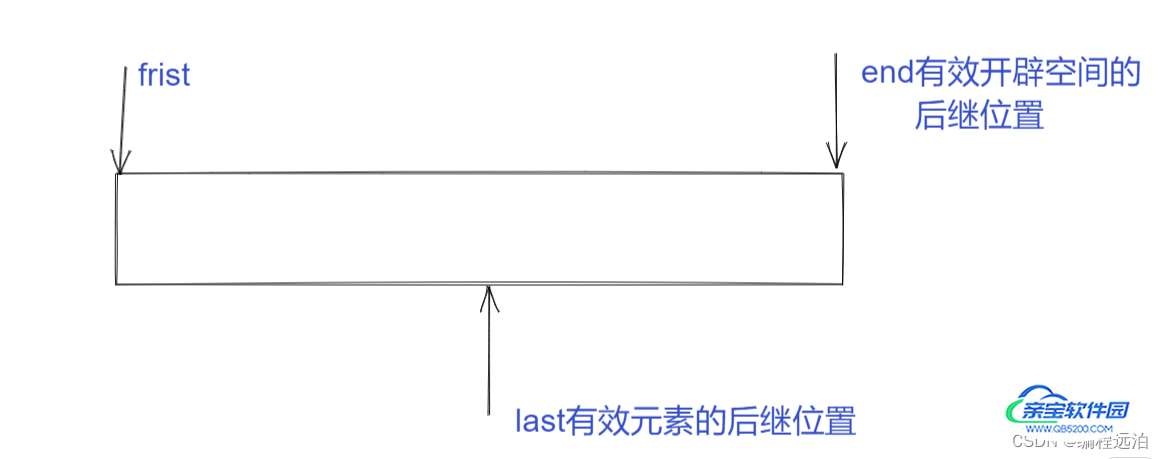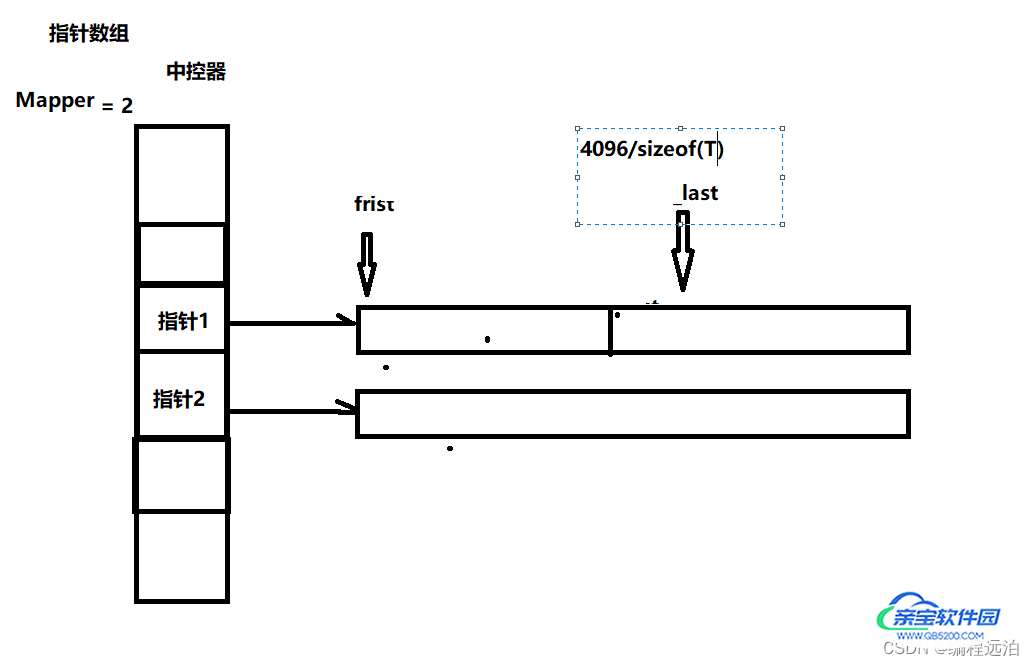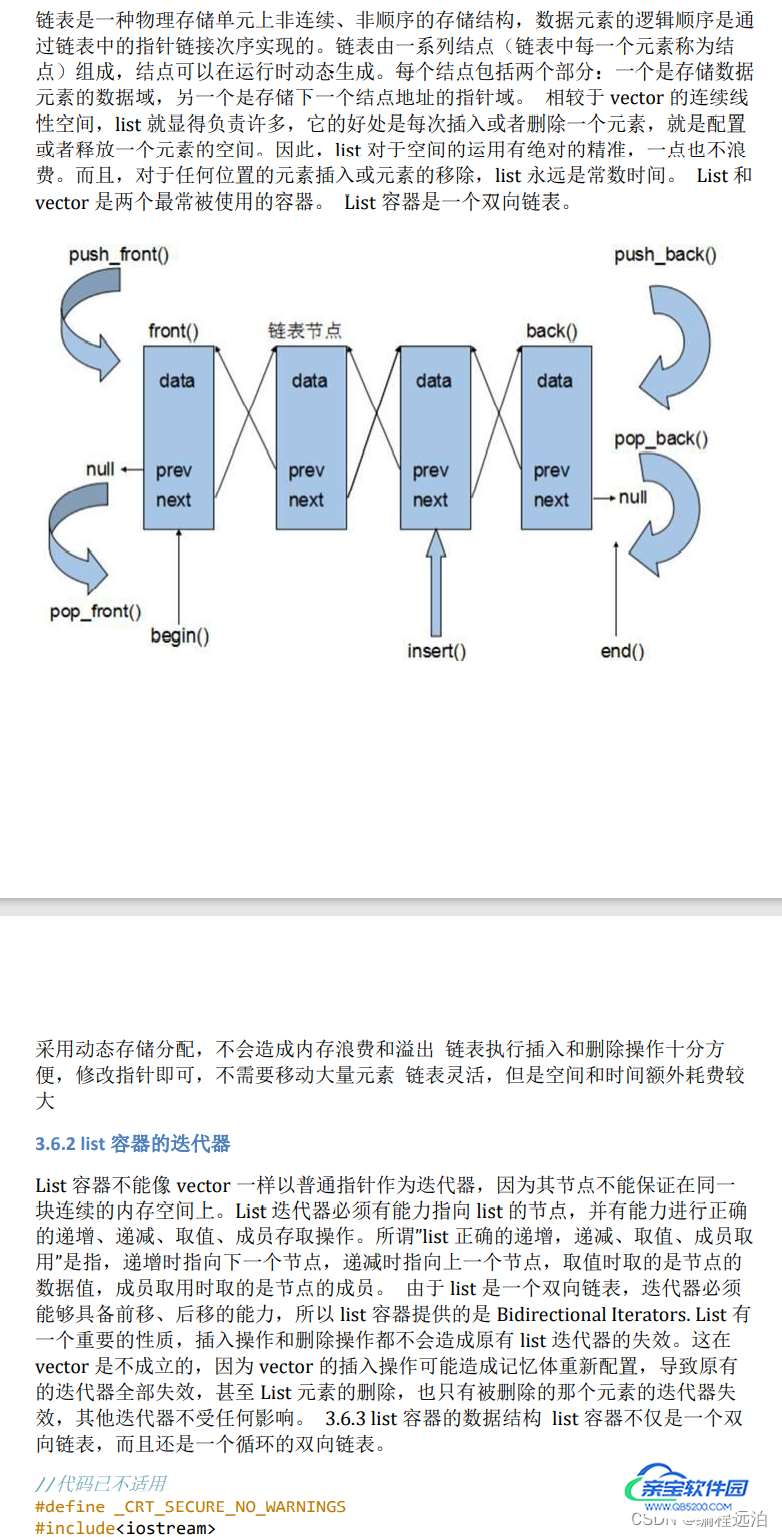STL采用泛型思想,把C中所用到的所有的数据结构,按照一定的标准,全部封装成了一个个类模板。也被称为数据容器。
STL就是用来解决容器中数据元素的操作的问题的。并且他按排标准统一封装了操作容器元素的算法,即一个个的函数模板。
为了配合统一的算法去操作不同的容器,他又按标准统一封装了不同的迭代器,即一个个不同类型的具有指针特性的类模板。
所以容器,算法,迭代器是整个STL的核心。
三者的关系如图所示:

有了统一的数据结构,即容器,有了统一的算法,每一个容器都使用各自的不同的迭代器,从而实现了对数据结构元素的标准操作。
STL的知识结构如图:

algorithom头文件中的定义相关的操作的一系列的函数模板
STL收录的算法经过了数学上的效能分析与证明,且是经过商业运行考验过的,是极具复用价值 的,包括常用的排序,查找等。
算法又可为为两种,质变算法,与非质变算法。
何为质变算法:是指运算过程中会更改区间内的元素的内容。例如:拷贝,替换,删除等。
何为非质变算法:是指运算过程中不会更改区间内的元素内容,例如:查找,计数,遍历,寻找极值等。
迭代器的设计思维-STL 的关键所在,STL 的中心思想在于将容器(container)和算法(algorithms)分开,彼此独立设计,最后再一贴胶着剂将他们撮合在一起。从技术角度来看,容器和算法的泛型化并不困难,c++的 class template 和 functiontemplate 可分别达到目标,如果设计出两这个之间的良好的胶着剂,才是大难题
提供一种方法,使之能够依序寻访某个容器所含的各个元素,而又无需暴露该容器的内部表示方式,迭代器就被发明了出来。

在STL中主要用来为泛型算法提供策略。
有四种形式:全局函数指针,成员函数指针,仿函数(函数对象),与匿名函数Lambda表达式。
作用:主是用来解决内存碎片化问题的,以及过多的构造无用对象的问题。
容器的空间配置器的作用是把对象的内存开辟和构造过程分开,对象析构和内存释放分离开 。那为什么要把对象的内存开辟和构造(new的两个作用)分开,对象的析构和内存释放(delete的两个作用)分开呢?
1)因为在使用容器的过程中,构造一个容器,我们只想要容器的内存空间,并不需要给我们在内存上构造一堆无用的对象出来(直接用new没有办法避免这个问题);当从容器中删除一个元素的时候,我们需要析构这个被删除对象,但是它占用的容器内存空间是不能释放的,因为容器还要使用;再比如我们需要释放一个容器的时候,需要先把容器里面有效对象元素析构一遍,而不是把容器所有元素都析构一遍(用delete无法避免这个问题),所以在操作容器的过程中,我们需要有选择性的分别去开辟内存,构造对象,析构对象,所以这就是空间配置器存在的意义。
C++ 标准STL里面提供的allocator空间配置器,默认的内存分配和释放就是依赖malloc和free实现的。SGI STL提供了两个版本的空间配置器,一级空间配置器和二级空间配置器。一级空间配置器的内存管理也是通过malloc和free实现的,但是SGI STL的二级空间配置器提供了一个内存池的实现。第二级配置器的设计思想为:
1.如果配置区块超过128 bytes,则移交给第一级配置器处理(空间配置器);
2.如果配置区块小于128 bytes,则采用内存池管理(memory pool)。每次配置一大块内存,则维护对应的自由链表(free-list),下次若再有相同大小的内存需求,就直接从 free-list 中拨出(没有就继续配置内存,具体后面讲述),如果客端释换小额区块,就有配置器回收到 free-list 中。
对于SGI STL的二级空间配置器的内存池实现机制,还是非常重要的,因为这既涉及了空间配置器,又涉及了一个内存池的实现机制,因此大家需要好好的理解它的原理,大家在手写C++空间配置器的过程中,使用过nginx的内存池作为空间配置器的内存管理方案,这又是一个新的积累。
字符串容器API接口:
#include <iostream>
using namespace std;
int main()
{
string str(15,'g');
string str10;
str10.assign(10,'k');
cout << str << endl;
string str1(str,5);
cout << str1 << endl;
string str2("yaoliang",8);
cout << str2 << endl;
const char* s1=str2.data();
const char* s=str2.c_str();
cout << s << endl;
//获取迭代器
string::iterator it;
for(it=str2.begin();it!=str2.end();it++){
cout << *it << " ";
}
cout << endl;
//获取反向迭代器
string::reverse_iterator it1;
for(it1=str2.rbegin();it1!=str2.rend();it1++){
cout << *it1 << " ";
}
cout << endl;
cout << str2.size() << endl;
cout << str2.length() << endl;
cout << str2.capacity() << endl;//已经开辟好的空间
cout << str2.max_size() << endl;//最大容量
//string 容量对象保存字符时,如果是小字符串(小于23个字节),会在栈上开辟空间
//如果是大对象(大于23个字节),会在堆上开辟空间
//查看动态开辟空间策略(2倍扩容)
// string str_test;
// cout << str_test.capacity() << endl;
// for(int i=0;i<1024;i++){
// cout << "string容器对象中的有效元素个数:" << str_test.size() <<
// ",string容器对象中的容量大小:" << str_test.capacity() << endl;//采取2倍扩容机制
// str_test.push_back('a');
// }
cout << str1.insert(0,3,'A') << endl;
cout << str1 << endl;
cout << str1.insert(0,"hello") << endl;
cout << str1.erase(0,6) << endl;
cout << str2.find("liang") << endl;
cout << str2.substr(3,5) << endl;
cout << str2.replace(3,5,"ming");
return 0;
}
vector与array无乎是一样的,连续的存储结构,两者的唯一的区别在于在空间上的灵活,数组需要提前指定长度,不量确定了就不能发生改变了,比较死板,不够灵活。比如出现拷贝长度大于了给定的空间,需要再重新定义一个足够空间的大小,然后把旧空间的内容再一个个拷贝到新的空间,非常麻烦。
c++11引入array主要是用来描述一种支持迭代器的C风格数组的,所以数组怎么用,array就怎么用,他定义在栈上,且长度固定不会涉及动态内存的开辟所以没有push_back,pop_back的相关方法,但是Vector这种动态的数组在开发更为常用,他底层对象在堆上,且长度是可变的。

vector容器是动态空间,他随着元素的加入,它的内部机制会自动扩充空间以容纳新的元素。vector的运用对于内存的合理利用与运用的灵活性有很大的帮助。我们再也不必害怕空间不足而一开始就定义一个巨大的数组了。
实现分析:

#include <iostream>
#include <vector>
using namespace std;
int main()
{
//动态扩容的策略(没内容不先开辟空间,不同于string)
vector<int> v;
for(int i=0;i<100;i++){
cout << "vector容器对象中的有效元素个数:" << v.size() << "vector容器容量的大小:" << v.capacity() << endl;
v.push_back(i);
}
return 0;
}
#include <iostream>
#include <vector>
using namespace std;
int main()
{
vector<int> v;
for(int i=0;i<20;i++){
v.push_back(rand()%100+1);
}
for(int i=0;i<v.size();i++){
cout << v[i] << " ";
}
cout << endl;
//insert后,迭代器非法化的问题
for(vector<int>::iterator it=v.begin();it!=v.end();it++){
if(0==*it%2){
it=v.insert(it,888);//返回值为迭代器类型
it++;//更新迭代器
}
}
for(int i=0;i<v.size();i++){
cout << v[i] << " ";
}
cout << endl;
//erase迭代器非法化的问题
for(auto it=v.begin();it!=v.end();){
if(0==*it%2){
it=v.erase(it);//返回值为容器类型
}else{
it++;
}
}
for(int i=0;i<v.size();i++){
cout << v[i] << " ";
}
cout << endl;
return 0;
}
泛型算法 = 函数模板 + 迭代器范围(注意迭代器的类型) + 函数符(策略使用)
#include <iostream>
#include <vector>
#include <algorithm>
using namespace std;
int main()
{
vector<int> v;
for(int i=0;i<20;i++){
v.push_back(rand()%100+1);
}
for(int i=0;i<v.size();i++){
cout << v[i] << " ";
}
cout << endl;
cout << "----------------使用泛型算法进行遍历-------------" << endl;
for_each(v.begin(),v.end(),[](int val){cout << val << "-";});
cout << endl;
//针对于容器中有迭代器的容器for_each算法,提供了一种变种:枚举for循环
for(int val:v){//val默认为第0个元素,一次遍历,直到结束为止
cout << val << "-" ;
}
cout << endl;
return 0;
}sort:
#include <iostream>
#include <vector>
#include <algorithm>
#include <functional>
using namespace std;
template <class T>
T my_greate(T t1,T t2){
return t1>t2;
}
template <class T>
class my_Greate{
public:
bool get_my_Greate(T t1,T t2){
return t1>t2;
}
};
int main()
{
vector<int> v;
for(int i=0;i<20;i++){
v.push_back(rand()%100+1);
}
for(int val:v){
cout << val << " " ;
}
cout << endl;
cout << "---------------------1---------------------" << endl;
//sort,ASC//升序
sort(v.begin(),v.end());
for(int k:v){
cout << k << " ";
}
cout << endl;
cout << "----------------------2--------------------" << endl;
//sort,DESC,使用lambda表达式作为算法策略
sort(v.begin(),v.end(),[](int val1,int val2){return val1>val2;});//一直判断到最后
//如果val1>val2为真,就把val1排好序,可以把函数符想象成一个抽象(必须这么理解,因为具体排序要看sort实现了),不是算法的具体实现,算法知道意思,就是降序了
for(int k:v){
cout << k << " ";
}
cout << endl;
cout << "----------------------3--------------------" << endl;
//使用函数对象
sort(v.begin(),v.end(),greater<int>());//这是调用库函数中的函数对象
for(int k:v){
cout << k << " ";
}
cout << endl;
cout << "----------------------4--------------------" << endl;
//定义一个函数指针,函数符来实现
sort(v.begin(),v.end(),&my_greate<int>);//这个就是全局函数指针,函数符实现
for(int k:v){
cout << k << " ";
}
cout << endl;
//定义一个成员函数指针,函数符来实现
//因为成员函数指针依赖于对象的调用,所以不可以有直接做为策略使用,需要绑定器进行对象绑定才可以
cout << "----------------------5--------------------" << endl;
my_Greate<int> m;
using namespace placeholders;
sort(v.begin(),v.end(),bind(&my_Greate<int>::get_my_Greate,&m,_1,_2));
for(int k:v){
cout << k << " ";
}
cout << endl;
return 0;
}binary_find:
#include <iostream>
#include <vector>
#include <algorithm>
using namespace std;
int main()
{
vector<int> v;
for(int i=0;i<20;i++){
v.push_back(rand()%100+1);
}
for(int val:v){
cout << val << " " ;
}
cout << endl;
//sort,ASC
sort(v.begin(),v.end());
for(int k:v){
cout << k << " ";
}
cout << endl;
//时间复杂度O(logn)
bool ok=binary_search(v.begin(),v.end(),70);
if(ok)
cout << "find succeed!" << endl;
else
cout << "find failure!" << endl;
return 0;
}find&&find_if&&bind1st(绑定第一个参数)&&bind2nd(绑定第二个参数)&&bind(新式绑定器):
#include <iostream>
#include <vector>
#include <algorithm>
#include <functional>
using namespace std;
int main()
{
vector<int> v;
for(int i=0;i<20;i++){
v.push_back(rand()%100+1);
}
for(int val:v){
cout << val << " " ;
}
cout << endl;
//find对容器中的值没有要求,时间复杂度O(n),顺序遍历一遍,和二分查找不一样,时间复杂度不同
auto it=find(v.begin(),v.end(),70);
if(it!=v.end()){
cout << "find succeed!index:" << it-v.begin() << endl;
}else{
cout << "find failure!" << endl;
}
//find_if按条件查找,需要把一个2这个值按序插入到序列中
it=find_if(v.begin(),v.end(),[](int val){return val < 2;});
if(it!=v.end()){
it=v.insert(it,2);
it++;
cout << "find succeed!" << endl;
}else{
cout << "find failure!" << endl;
}
for(int val:v){
cout << val << " " ;
}
cout << endl;
//老式绑定器bind1st,bind2nd
it=find_if(v.begin(),v.end(),bind1st(greater<int>(),2));
if(it!=v.end()){
it=v.insert(it,2);
it++;
cout << "find succeed!" << endl;
}else{
cout << "find failure!" << endl;
}
for(int val:v){
cout << val << " " ;
}
cout << endl;
//新式绑定器:bind
using namespace placeholders;
it=find_if(v.begin(),v.end(),bind(greater<int>(),2,_1));
if(it!=v.end()){
it=v.insert(it,2);
it++;
cout << "find succeed!" << endl;
}else{
cout << "find failure!" << endl;
}
for(int val:v){
cout << val << " " ;
}
cout << endl;
return 0;
}
#include <iostream>
#include <vector>
#include <algorithm>
using namespace std;
//实现一个自定的空间配置器
template <class T>
struct Allocate{
//1.开辟空间
T* allocate(size_t size){
T* temp=(T*)malloc(sizeof (T)*size);
if(nullptr==temp){
throw bad_alloc();
}
return temp;
}
//2.构造对象
void constructor(T* p,const T& obj){
//定位new
new (p) T(obj);
}
//3.析构对象
void destructor(T* p){
p->~T();
}
//4.释放空间
void destroy(T* p){
free(p);
}
};
template <class T,class Allocat=Allocate<T>>
class Vector{
private:
T* _frist;
T* _last;
T* _end;
Allocat _allcater;
public:
Vector(int size=10){
// this->_frist=new T[size];
this->_frist=_allcater.allocate(size);
this->_last=_frist;
this->_end=this->_frist+size;
}
~Vector(){
if(nullptr!=this->_frist){
// delete [] this->_frist;
for(T* p=_frist;p!=_last;p++){
_allcater.destructor(p);
}
}
_allcater.destroy(_frist);
this->_end=this->_last=this->_frist=nullptr;
}
//拷贝构造
Vector(const Vector& other){
int size=other._end-other._frist;
// this->_frist=new T[size];
this->_frist=_allcater.allocate(size);
int len=other._end-other._frist;
memmove(this->_frist,other._frist,sizeof (T)*len);
this->_last=this->_frist+len;
this->_end=this->_frist+size;
}
//等号运算符重载
Vector& operator=(const Vector& other){
if(this==&other){
return *this;
}
int size=other._end-other._frist;
int len=other._last-other._frist;
if(nullptr!=this->_frist){
// delete [] this->_frist;
// this->_frist=new T[size];
for(T* p=_frist;p!=_last;p++){
_allcater.destructor(p);
}
_allcater.destroy(_frist);
this->_frist=_allcater.allcate(size);
}else{
// this->_frist=new T[size];
this->_frist=_allcater.allcate(size);
}
memmove(this->_frist,other._frist,sizeof (T)*len);
this->_last=this->_frist+ len;
this->_end=this->_frist+size;
return *this;
}
bool full(){
return this->_last==this->_end;
}
bool empty(){
return this->_last==this->_frist;
}
//2倍扩容
void expand(){
int size=this->_end-this->_frist;
// T* temp=new T[size* 2];
T* temp=_allcater.allocate(size*2);
memmove(temp,this->_frist,sizeof (T)*size);
// delete [] this->_frist;
for(T* p=_frist;p!=_last;p++){
_allcater.destructor(p);
}
_allcater.destroy(_frist);
this->_frist=temp;
this->_last=this->_frist+size;
this->_end=this->_frist+size*2;
}
void push_back(const T& val){
if(this->full()){
this->expand();
}
// *_last++=val;
_allcater.constructor(this->_last,val);
_last++;
}
void pop_back(){
if(this->empty()){
return;
}
// _last--;
_last--;
_allcater.destructor(_last);
}
int size(){
return this->_last-this->_frist;
}
int capacity(){
return this->_end-this->_frist;
}
T& operator[](int index){
if(index<0||index>=this->size()){
throw out_of_range("越界!");
}
return this->_frist[index];
}
class iterator{
public:
//与标准库中的泛型算法匹配类型
using difference_type=int;
using value_type= T ;
using pointer=T*;
using reference=T&;
using iterator_category=random_access_iterator_tag;
private:
T* ptr;
public:
iterator(T* ptr=nullptr){
this->ptr=ptr;
}
//迭代器功能:++运算,!=运算
iterator& operator++(){
++this->ptr;
return *this;
}
iterator& operator++(int){
this->ptr++;
return *this;
}
iterator& operator--(){
--this->ptr;
return *this;
}
iterator& operator--(int){
this->ptr--;
return *this;
}
// !=运算符重载:
bool operator!=(const iterator& other){
return this->ptr!=other.ptr;
}
bool operator==(const iterator& other){
return this->ptr==other.ptr;
}
T& operator*(){
return *ptr;
}
T* operator->(){
return ptr;
}
iterator& operator+=(int n){
this->ptr+=n;
return *this;
}
iterator& operator-=(int n){
this->ptr-=n;
return *this;
}
iterator operator+(int n){
T* temp=this->ptr+n;
return iterator(temp);
}
iterator operator-(int n){
T* temp=this->ptr-n;
return iterator(temp);
}
int operator-(const iterator& other){
return this->ptr-other.ptr;
}
bool operator>(const iterator& other){
return this->ptr - other.ptr > 0;
}
bool operator<(const iterator& other){
return this->ptr - other.ptr < 0;
}
bool operator>=(const iterator& other){
return !(*this < other);
}
bool operator<=(const iterator& other){
return !(*this > other);
}
T* get(){
return ptr;
}
};
iterator begin(){
return iterator(this->_frist);
}
iterator end(){
return iterator(this->_end);
}
};
class A{
public:
A(){
cout << "A structure" << endl;
}
~A(){
cout << "A destruct" << endl;
}
A(const A&other){
cout << "A copy" << endl;
}
};
int main()
{
Vector<int> v;
for(int i=0;i<20;i++){
v.push_back(rand()%100+1);
}
for(int i=0;i<v.size();i++){
cout << v[i] << " " ;
}
cout << endl;
Vector<A> v1;
Vector<int> v2;
for(int i=0;i<20;i++){
v2.push_back(rand()%100+1);
}
for(int k:v2){
cout << k << " " ;
}
cout << endl;
return 0;
}

#include <iostream>
#include <deque>
#include <algorithm>
using namespace std;
int main()
{
deque<int> dq;
for(int i=0;i<20;i++){
dq.push_front(rand()%100+1);
}
for(auto it=dq.begin();it!=dq.end();it++){
cout << *it << " ";
}
cout << endl;
sort(dq.begin(),dq.end());
for(int k:dq){
cout << k << " ";
}
cout << endl;
for(int i=0;i<20;i++){
cout << dq.back() << " ";
dq.pop_back();
}
cout << endl;
for(int i=0;i<20;i++){
cout << dq.front() << " ";
dq.pop_front();
}
cout << endl;
return 0;
}容器适配器是没有迭代器的,不能实现泛型算法
使用deque容器实现一个stack
#include <iostream>
#include <deque>
using namespace std;
template <class T,class Container=deque<T>>
class Stack{
private:
Container container;
public:
void push(const T& val){
container.push_back(val);
}
void pop(){
container.pop_back();
}
T& top(){
return container.back();
}
bool empty(){
return container.empty();
}
};
int main()
{
Stack<int> s;
for(int i=0;i<10;i++){
s.push(i);
cout << i << " ";
}
cout << endl;
while (!s.empty()) {
cout << s.top() << " ";
s.pop();
}
cout << endl;
return 0;
}实现一个单端队列
#include <iostream>
#include <deque>
using namespace std;
template <class T,class Container=deque<T>>
class SimpleQ{
private:
Container container;
public:
void push(const T& val){
container.push_back(val);
}
void pop(){
container.pop_front();
}
T& top(){
return container.front();
}
bool empty(){
return container.empty();
}
};
int main()
{
SimpleQ<int> q;
for(int i=0;i<10;i++){
q.push(i);
cout << i << " ";
}
cout << endl;
while (!q.empty()) {
cout << q.top() << " ";
q.pop();
}
cout << endl;
return 0;
}优先队列
#include <iostream>
#include <vector>
#include <algorithm>
using namespace std;
template<class T,class Container=vector<T>,class Compair=less<T>>
class Priority_queue{
private:
Container container;
Compair compair;
public:
Priority_queue(){
make_heap(container.begin(),container.end(),compair);
}
void push(const T& val){
container.push_back(val);
// sort(container.begin(),container.end(),compair);//快排,但系统中采取的是大顶堆,原因快排,递归过多
push_heap(container.begin(),container.end(),compair);
}
void pop(){
pop_heap(container.begin(),container.end(),compair);
container.pop_back();
}
T& top(){
return container.front();
// return container.back();
}
bool empty(){
return container.empty();
}
};
int main()
{
Priority_queue<int> pq;
for(int i=0;i<20;i++){
pq.push(rand()%100+1);
}
while (!pq.empty()) {
cout << pq.top() << " ";
pq.pop();
}
cout << endl;
return 0;
}
#include <iostream>
#include <list>
#include <algorithm>
using namespace std;
int main()
{
list<int> l;
for(int i=0;i<20;i++){
l.push_back(rand()%100+1);
}
for(int k:l){
cout << k << " ";
}
cout << endl;
l.sort();
for_each(l.begin(),l.end(),[](int val){cout << val << " ";});
cout << endl;
l.sort([](int val1,int val2){return val1>val2;});
for_each(l.begin(),l.end(),[](int val){cout << val << " ";});
cout << endl;
return 0;
}Set特性是:所有元素都会根据元素的键值自动被排序。(set 与 map都会按照键值来自动排序,只不过set的键与值是一体的相同的)Set的元素不像map那样,可以同时拥有实值与键值,set的元素即是键值又是实值。(你也可以理解为只有一个值,键与值相同)Set不允许两个元素有相同的键值。(即然是自动排序,set与map是不允许有相同的键的存在。这一点与map是共同的。),而multiset是可以存相同键值的元素。(这是set与multiset的唯一区别。)。
所以set容器的迭代器是一个常双向迭代器,只支持什么:++,–,==,!=的操作。
我们可以通过set的迭代器改变set元素的值吗?不行,因为set元素值就是其键值,关系到set元素排序规则,如果任意改变set元素值,会严重破坏set组织结构。换句话说,set的迭代器是一个只读迭代器。
set容器拥有与list某些相同的性质,当对容器中的元素进行插入操作或者删除操作的时候,操作之前所有迭代器,在操作完成之后依
multiset的底层实现是红黑树,红黑树是平衡二叉树的一种。二叉树的相关知识点可以百度一下。
#include <iostream>
#include <set>
using namespace std;
class Stu{
private:
string name;
int age;
public:
Stu(string name,int age){
this->age=age;
this->name=name;
}
// bool operator<(const Stu& other)const{
// return this->age<other.age;
// }
void showInfo()const{
cout << "姓名:" << name << ",年龄:" << age << endl;
}
int getAge(){
return this->age;
}
};
template <class T>
class Myless{
public:
bool operator()(T t1,T t2)const{
return t1.getAge()<t2.getAge();
}
};
int main()
{
set<int> s;
for(int i=0;i<20;i++){
s.insert(rand()%100+1);
}
for(int k:s){
cout << k << " ";
}
cout << endl;
cout << "*********************自定义类型放入set****************" << endl;
Stu stu1("yaoliang",19);
Stu stu2("minmin",18);
Stu stu3("sun",17);
// set<Stu> s1;//调用库中的<预算符重载函数
// s1.insert(stu1);
// s1.insert(stu2);
// s1.insert(stu3);
// for(const Stu& stu:s1){
// stu.showInfo();
// }
set<Stu,Myless<Stu>> s1;//自定义比较策略
s1.insert(stu1);
s1.insert(stu2);
s1.insert(stu3);
for(const Stu& stu:s1){
stu.showInfo();
}
return 0;
}multiset与set
#include <iostream>
#include <set>
using namespace std;
class Stu{
private:
string name;
int age;
int id;
public:
Stu(string name,int age,int id){
this->age=age;
this->name=name;
this->id=id;
}
bool operator<(const Stu& other)const{
return this->id<other.id;
}
void showInfo()const{
cout << "学号:" << id << ",姓名:" << name << ",年龄:" << age << endl;
}
int getAge(){
return this->id;
}
};
int main()
{
Stu stu1("王大锤",19,1);
Stu stu2("李二狗",18,2);
Stu stu3("张三丰",17,3);
Stu stu4("王五子",17,5);
Stu stu5("刘四思",20,3);
// set<Stu> s1;//调用库中的<预算符重载函数
multiset<Stu> s1;
s1.insert(stu1);
s1.insert(stu2);
s1.insert(stu3);
s1.insert(stu5);
s1.insert(stu4);
// pair<set<Stu>::iterator,bool> p;
// p=s1.insert(stu4);
// if(p.second){
// cout << "王五子入学成功!" << endl;
// }else{
// cout << " 王五子入学失败!" << "\n";
// }
for(const Stu& stu:s1){
stu.showInfo();
}
return 0;
}对组pair构建方式:
#include <iostream>
#include <map>
using namespace std;
int main()
{
pair<string,int> p1("zhangsan",1001);
cout << p1.first << "," << p1.second << endl;
pair<string,int> p2={"lisi",1002};
cout << p2.first << "," << p2.second << endl;
pair<string,int> p3;
p3.first="maliu";
p3.second=1003;
cout << p3.first << "," << p3.second << endl;
pair<string,int> p4=make_pair("wangwu",1004);
cout << p4.first << "," << p4.second << endl;
pair<string,int> p5=map<string,int>::value_type("tianqi",1005);
return 0;
}Map容器的特性是:所有元素都会根据元素的键的值自动排序。Map所有的元素都是统一的pair对组,同时拥有键值Key实值Value,pair的第一元素被视为键值,第二个元素被视为实值,map不允许两个元素有相同的键。
我们可以通过map迭代器改变map的键值吗?答案是不行,因为map的键值关系到map的元素的排列布局,Map中的键是不可修改的,但是键对应的值是可以修改的。
所以Map的迭代器是一个双向迭代器,只支持++ == !=操作。
Map是可以随时插入或删除键值对的。
Map与multimap的唯一区别是multimap中的键是可以重复的。
Map的底层实现机制是由二叉树中的红黑树进行实现的。
#include <iostream>
#include <map>
using namespace std;
int main()
{
pair<string,int> p1("zhangsan",1001);
pair<string,int> p2={"lisi",1002};
pair<string,int> p3;
p3.first="maliu";
p3.second=1003;
pair<string,int> p4=make_pair("wangwu",1004);
pair<string,int> p5=map<string,int>::value_type("tianqi",1005);
map<string,int> m1;
m1.insert(p1);
m1.insert(p2);
m1.insert(p3);
m1.insert(p4);
m1.insert(p5);
for(pair<string,int> p:m1){
cout << p.first << p.second << endl;
}
cout <<m1.at("zhangsan") << endl;
// cout <<m1.at("********") << endl;
cout << m1["zhangsan"] << endl;
cout << "------------------map[] not exist throw-------------" << endl;
cout << m1["**********"] << endl;//副作用,会保存不存在的值
for(pair<string,int> p:m1){
cout << p.first << p.second << endl;
}
cout << "-----------------find-------------" << endl;
auto it=m1.find("lisi");
if(it!=m1.end()){
cout << it->first << "," << it->second << endl;
}else{
cout << "no find!!!" << endl;
}
return 0;
}注意:multimap中是没有【】中括号运算符的:
map中的[]注意事项:
map中的[]运算符具有两个作用:
1.就是可以在map容器直接插入一个键值对。
2.当map容器有同名的key时,使用[]也可修饰key对应的value的值。
3.注意:在multimap中是没有[]中括号运算符的。
4.中括号运算符如果map没有这个键时,将会自动插入这个键值对。
用来解决两个不相关对象之间的一对一或者一对多的通信模型。
观察者模式是一种对象行为模式。它定义对象间的一种一对多的依赖关系, 当一个对象的状态发生改变时,所有依赖于它的对象都得到通知并被自动更新。在观察者模式中,主体是通知的发布者,它发出通知时并不需要知道谁是它的观察者,可以有任意数目的观察者订阅并接受通知。观察者模式不仅被广泛应用于软件界面元素之间的交互,在业务对象之间的交互、权限管理等方面也有广泛的应用。
定义了对象间的一种一对多的组合关系,以便一个对象的状态发生时,所有依赖于它的对象都得到通知并自动刷新。
观察者和被观察者之间存在“观察”的逻辑关系,当被观察者发生变化时,观察者就会观察到这样的变化,并作出相应的响应。
设定两者类,一个为观察者类,一个为被观察者类
观察者类中,定义一个对某个事件感兴趣的处理函数,一般也叫做槽函数
被观察者类中,定义一个数据结构,用来保存观察者对某一个事件id(信号)感兴趣,使用数据结构建立信号与对象之间的映射关系
被观察者类中,定义两个方法函数:
一个方法为:添加观察者与其感兴趣的事件id(信号)加入到容器中
另一个方法为:信号函数:通知事件函数执行逻辑:首先遍历容器中,有没有感兴趣的事件ID,如果有,则代表一系列的观察者,对这个事件感兴趣,那么再次遍历观察者列表,让每一个观察者执行相应的槽函数
#include <iostream>
#include <map>
#include <list>
using namespace std;
class RecvBase
{
public:
RecvBase(){
cout << "--------------RecvBase structure------------------" << endl;
}
virtual void slotFunctions(int msgid)=0;
virtual~RecvBase()
{
cout << "--------------RecvBase destruct------------" << endl;
}
};
class Recv:public RecvBase
{
public:
void slotFunctions(int msgid)override
{
switch(msgid)
{
case 1:
cout << "接收到1信号,执行信号1对应槽函数逻辑" << endl;
break;
case 2:
cout << "接收到2信号,执行信号2对应槽函数逻辑" << endl;
break;
case 3:
cout << "接收到3信号,执行信号3对应槽函数逻辑" << endl;
break;
case 4:
cout << "接收到4信号,执行信号4对应槽函数逻辑" << endl;
break;
}
}
Recv()
{
cout << "--------------structure--------------" << endl;
}
~Recv()override
{
cout << "--------------destruct------------" << endl;
}
};
class Sender
{
public:
map<int,list<RecvBase*>> recvMap;
void addRecvToMap(int msgid,RecvBase* recv)
{
this->recvMap[msgid].push_back(recv);
}
void signals(int msgid)
{
auto it=recvMap.find(msgid);
if(it!=recvMap.end())
{
for(RecvBase* p:it->second)
p->slotFunctions(msgid);
}else
{
cout << "接受到未知信号,没有信号对应的槽函数逻辑" << endl;
}
}
};
int main(){
Sender sender;
RecvBase* r1=new Recv();
RecvBase* r2=new Recv();
RecvBase* r3=new Recv();
RecvBase* r4=new Recv();
sender.addRecvToMap(1,r1);
sender.addRecvToMap(2,r2);
sender.addRecvToMap(3,r3);
sender.addRecvToMap(4,r4);
int msgid;
while(true)
{
cin >> msgid;
if(-1==msgid)break;
sender.signals(msgid);
}
delete r1;
delete r2;
delete r3;
delete r4;
return 0;
}